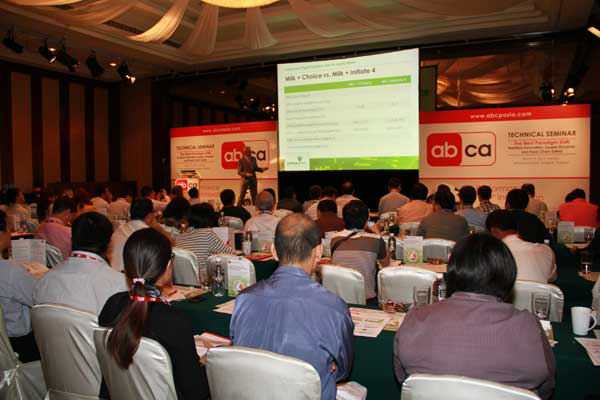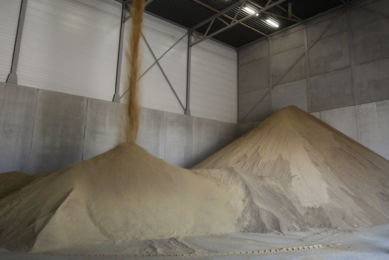Commercial nutritionist objective – Profit!

During the ABCA Technical Seminar organised in Bangkok on 12 March, ahead of the VIV Asia 2013, Paul Toplis of Primary Diets gave a presentation on advanced piglet nutrition.
He presented data on the lifetime performance effects of high versus low cost starter diets on light, medium and heavy weaning pigs. Only pigs weaned above 9.5kg appeared to be more profitable on low cost diets with light and medium pigs having lower lifetime feeding costs despite the higher cost of the starter diet. It implied the effectiveness of selecting appropriate starter feed for individual pens depending on the weaning weight and the importance of measuring total income over feed cost.
He then showed the consequences of large litters, well above 30 pigs and possibly targeting 40 pigs per sow per year. A large number of piglets per sow is a challenge because the average piglet birth weight tends to get lower proportionally, which in turn increases the post weaning mortality and reduces weight for age. These negative impacts can be overcome with appropriate milk systems and creep feeding. A good start for piglets is as important a key for the commercial objectives of nutritionists as maximising lean tissue growth rate and skeletal development while minimising back fat, feed cost, digestive disturbance & vices and nutrient waste.
Artificial milk systems help by enhancing the litter weight gain, but they are relatively expensive, Toplis showed some calculations and margin level per litter. Then what about creep feeding? Pigs eating creep feed improves post-wean performance. Furthermore, compared to simple feed composition formula, complex feed composition formula increases number of eaters ie. appetite, especially in light pig category.
We are aware that an optimal feed intake is key for piglet growth. But how can we increase the feed intake? First, Toplis used management examples such as water supplying system and feeder space as well as feed coverage in pans. He then went on to illustrate the importance of health status and how this interacts with diet formulation. When a range of identical diets were fed at a high health and a disease challenged university unit, performance and profit were achieved on different diets. Toplis said this illustrated the need to carry out nutrition research across a range of health status scenarios and that pig producers should always carry out their own farm trials to find which diets maximise their income over feed cost.
According to his calculations, starter feed account for up to 6.25% of the entire feed bill (see graph). Starter feeds are the most expensive diets on the farm. Do piglets need a starter feed in the first place? A trial comparing 2kg versus no prestarter diet showed it was a very expensive mistake to try to ‘save’ money by cutting out the expensive prestarter diet. At the same time, different starter diet inclusion levels have effects on the daily gain, daily feed intake, feed efficiency and feed cost. The table shows that the total feed cost rose by 50p when the inclusion levels between 6kg and 8kg but the value of the pig by more than double that (£1.10) but feeding more (10kg or 12kg per pig) just increased feed cost without increasing performance and value. which indicates that too much starter feed as well as too little reduces profit..
Next, Toplis showed trial results of piglet weight on day 14 for seven trial groups, each with the same diet formula with 10% whey inclusion, however purchased from seven different suppliers to an identical specification. The daily weight gain varied from 308g to 349g per day, and the higher quality whey resulted in 0.6kg extra weight at day 14. The potential lifetime saving is GBP 2-3 per pig, indicating that whey quality pays for itself. The problem was that chemical analysis could not distinguish between the whey sources and only a piglet trial would reveal the scale of the difference. Toplis said this was another example of why pig producers should carry out farm trials and let their piglets tell them what works on their farm!
He also addressed the disease challenge of piglets which reduces feed intake and also causes inefficiencies in nutrient absorption and metabolism. As an example of this he showed that immune challenged pigs required higher dietary tryptophan relative to lysine than healthy pigs.
Finally, the presentation showed performance effects of different inclusion levels of crude protein and lactose, effect of porcine plasma, and effect of various combinations of yeast extract and whey powder contents, and nucleotide.
| Speaker, Paul Toplis, Technical Director of Primary Diets Toplis presented several examples of small improvements in performance before and after weaning from better diets were shown to lead to bigger improvements throughout the entire life of the pig. The improvements in lifetime performance always gave a significant economic payback on the investment in better diets around weaning. Toplis is a recipient of the David Black award for outstanding and sustained contribution to the UK pig industry. |











